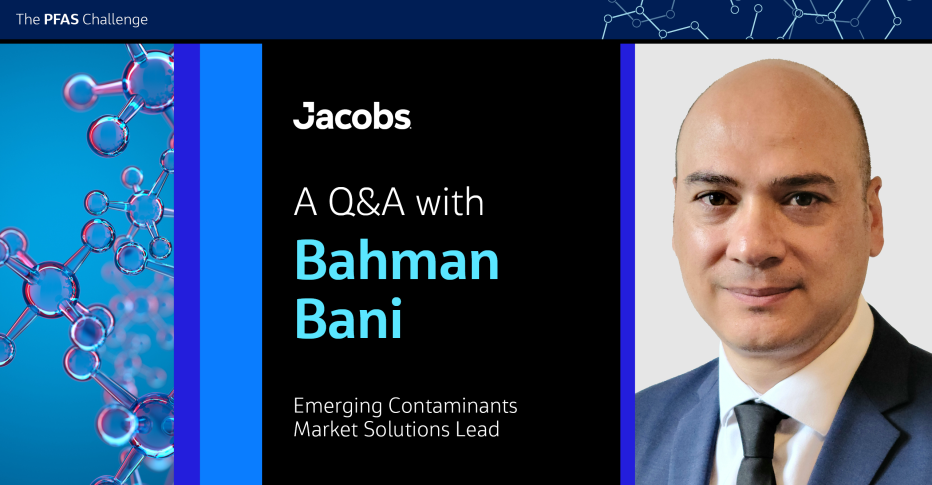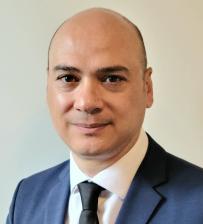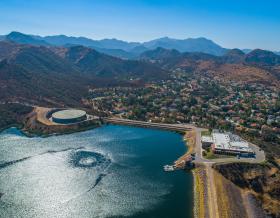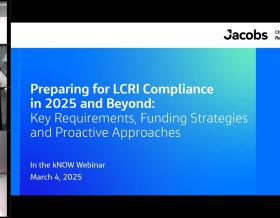
While per- and polyfluoroalkyl substances (PFAS) have been around since the 1950s, the scale of their true impact is exploding due to us now having a better understanding of what they are and their effects on the environment, animals and humans.
There are almost 15,000 known PFAS synthetic chemicals and many of them are highly mobile and persistent, which is how they earned their media nickname of ‘forever chemicals.’ The bad news is due to PFAS being thousands of industrial and household products, these bio accumulative chemicals can be found almost everywhere — including our bloodstreams — and research shows they are damaging for our health and the environment. The good news is that they can be treated and remediated with the right talent and technology — they aren’t a ‘forever’ problem.
We sat down with Jacobs Emerging Contaminants Community of Practice Co-Leader, Bahman Bani, to better understand the dynamics of evolving PFAS regulations, how our approaches are shifting in response and the PFAS challenges he confronts daily. Bahman is renowned for his expertise in dealing with complex emerging contaminants, notably PFAS, and for him, the thrill of exploring novel ideas and concepts is a highlight of his interactions with clients and project sites.
Can you tell us how you support our clients to respond to the changing PFAS regulatory and compliance demands?
The PFAS threat potential, both for the environment and humans, has driven widespread regulatory and liability changes, and has already led to multi-billion-dollar settlements by chemical companies. One company in particular was ordered to pay $12.5 billion in a lawsuit in 2023. With regulations constantly changing, the industry is facing concerns it didn’t have previously, creating a lot of uncertainty. Because PFAS are widely used, many industries including military installations, airports, manufacturers and the oil and gas sector are impacted — and therefore the communities near those facilities are too.
So, long-story-short, there is no one-size-fits-all solution. Every client has a different strategy in mind and we need to understand their unique needs. Our clients want to ensure they comply with the regulations and understand how they will impact them. In this way, we are trusted partners that manage their risk based on their corporate strategy and goals. Whether it’s a cleanup strategy or a usage strategy, PFAS is another piece of the puzzle for our clients and we help them solve it.
One recent example is our work with City of North Bay and the Department of National Defence to address PFAS at Jack Garland Airport in Ontario, Canada. As a remediation lead for this project, I assisted the client to accelerate the innovative and integrated remedy solution in the firefighting training area (FFTA) to advance remediation in a key source area, meeting the financial spending plans consistent with the client Contribution Agreement. Our client also noted our ability to communicate the highly technical aspects of the project to stakeholders including City staff, residents, interest groups, federal and provincial government and regulators.
What do you think is the most important thing companies can do right now to get ready for regulatory enforcement?
The first thing they can do is look at their risk. When we meet with a client, the first thing we help them understand is their risk profile. Have they used PFAS in their products or operations in the past? Was there a spill on their site? If it’s undetermined for these clients, we can help them understand their risk and navigate the regulatory requirements.
The second thing is to look at their regulatory strategy and see what actions would fit best within that plan. To comply doesn’t necessarily mean we must immediately remediate the entire site. That might not be what’s best for the client. We support and advise them on how regulation impacts them and their business.
What technologies is Jacobs developing to help clean up PFAS-impacted sites?
Currently, most available water technologies use media to filter out PFAS. This type of technology, including pump and treat systems, is expensive and requires high levels of maintenance. At Jacobs, we’re considering addressing PFAS through cost-effective and nature-based solutions. For instance, instead of spending millions of dollars on excavating the materials, we can immobilize PFAS in place or use bacteria or microorganisms to do part of the job.
PFAS are often mistakenly called “forever chemicals,” as it refers to the widely held misperception that PFAS chemicals can’t break down in nature. We’re challenging that stance now because we understand certain organisms and other natural processes can transform PFAS into different compounds. We’ve investigated this in various pilot studies globally to understand how these microorganisms can address PFAS compounds in the environment. So now, when we have impacted soil, instead of excavating and hauling it to restricted sites, we’re looking at potential ways of addressing it through organic, nature-based solutions.
How do you foresee the landscape of PFAS evolving?
We see a couple of things changing, with the most prominent being regulation. With the introduction of the proposed Maximum Contaminant Levels (MCLs), there will be a shift in clients who want to be more proactive.
We understand that some clients will still want to wait and we can help them prepare for when they’re ready to make changes. We can help them identify the sources and risks so they can understand the impact and prepare for the future.
What is Jacobs doing differently in the PFAS and emerging contaminants space?
For starters, we’re using tailored technology to better understand the sources of PFAS. Because PFAS is so widespread, it’s incredibly challenging to identify the true source. If we don’t clearly understand those sources, it makes planning and remediation much more complicated. To combat this, we developed a pioneering PFAS evaluation toolset which provides a source differentiation for PFAS. Using the tool can help a team understand where the PFAS is coming from and how you can remediate it.
Another critical factor to understand is that PFAS generally doesn’t fit into just one sector. Whether in soil or water, our clients’ PFAS concerns cross multiple markets and processes. What sets Jacobs apart is we have all the cross-sector expertise needed to effectively tackle PFAS in one place. There are very few companies that can do that.
About the interviewee

Dr. Bahman Bani has over 15 years of global consulting and project management experience in contaminated sites management, including site characterization, soil and groundwater remedial design and implementation (including PFAS), water quality assessments, sampling and monitoring, hydrogeological investigations, specifications and tender documents and environmental remediation compliance audits. Dr. Bani currently serves as both an Emerging Contaminants Market Solutions Lead and a Global Community of Practice Co-Leader, serving approximately 800 global staff at Jacobs.












































